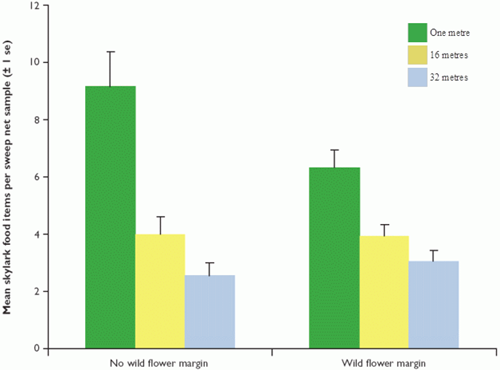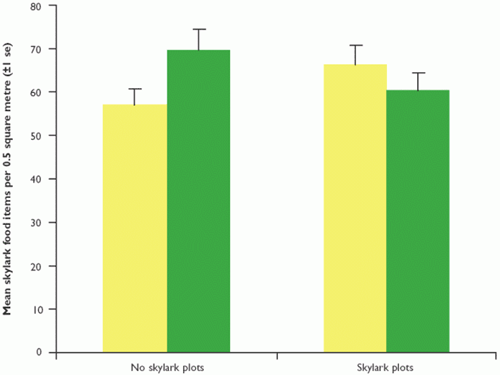In 2007, we completed the final phase of the five-year Sustainable Arable Farming for an Improved Environment (SAFFIE) project, in which we collaborated with others to find ways of increasing biodiversity in winter wheat. In this experiment we tested two management options separately and in combination: skylark plots and six-metre-wide wild flower margins (both options in Environmental Stewardship).
We knew that the wildflower margins supported high numbers of invertebrates but our main aim was to determine whether these spilled over into the adjacent crop and skylark plots, providing a boost in food resources for birds that prefer to forage in more open vegetation crop.
On each of 15 farms there were four treatments in conventional wheat fields, plots and wild flower margins:
- No skylark plots or wild flower margins
- Skylark plots only
- Wild flower margins only
- Skylark plots and wild flower margins
Over three years, we sampled the four fields on each farm in both first-year and second-year wheat. Using pitfall traps, a suction sampler and sweep net, we collected invertebrates on transects at one metre, 16 metres and 32 metres from the crop edge. We also collected mid-field samples. Here we present the results, averaged across a year, for the grey partridge chick-food index (CFI), specifically calibrated for suction samples, and skylark food-items (SFI), sampled by both suction sampler and sweep net. The CFI measures invertebrate food in terms of grey partridge chick survival; 0.7 is considered a good score.
In general, there were more invertebrates at the crop edge than in the crop. In standard fields, there were 71% fewer skylark food items (sampled by sweep net) at 32 metres than at one metre from the crop edge; in fields with wild flower margins there were 51% fewer at 32 metres than at one metre (see Figure 1). Although not statistically significant, grey partridge invertebrate food and skylark food items (sampled by suction sampler) were also higher in abundance at the crop edge.
There were 31% fewer skylark food items at the crop edge in fields with wild flower margins than at the edge of standard fields; we suggest that either the insects moved into the margins where there was more food or the insects were eaten by predators residing in the margins. These results emphasise how, in standard fields, the crop edge is important for invertebrates and the birds that feed on them. For this reason, we have long recommended selectively sprayed conservation headlands to provide some weed cover for invertebrates in standard fields.
Mid-field, there was an unexpected effect of combining wild flower margins with skylark plots. In fields without skylark plots, wild flower margins led to a 23% increase in SFI (see Figure 2). Conversely, in fields with skylark plots, the presence of wild flower margins led to a 9% decrease. It is possible that this was due to higher predation by birds, as skylark densities were between 1.3 and 2.8 times higher on fields with skylark plots and wild flower margins than in fields without these habitats.
We knew that the wildflower margins supported high numbers of invertebrates but our main aim was to determine whether these spilled over into the adjacent crop and skylark plots, providing a boost in food resources for birds that prefer to forage in more open vegetation.
Figure 1: Mean skylark food items per sweep net (back transformed data) sampled at 1m, 16m and 32m from the crop edge

However, this pattern was not replicated for grey partridge chick food items or skylark food items sampled by sweep net. Overall, the abundance of invertebrates in wheat was low; the CFI was frequently lower than 0.5, which indicates poor partridge chick survival. There is some evidence that skylarks, which avoid the edges of fields, may have benefited from skylark plots by gaining access to food, but we have found no robust evidence to suggest that wild flower margins or skylark plots boosted overall abundance of invertebrate birdfood.
Figure 2: Mean skylark food items per 0.5 square metre (back transformed data) in fields with and without skylark plots and wild flower margins

Indeed, combining these options reduced the abundance of skylark food in the middle of fields. Conventional herbicide regimes were in place, thereby limiting weed cover and the insects associated with weeds. The utility of measures such as skylark plots and wild flower margins can be maximised only if more selective herbicide regimes are introduced.
Acknowledgements
Our research partners in the SAFFIE project (LK0926) were:
- ADAS
- Royal Society for the Protection of Birds (RSPB)
- British Trust for Ornithology (BTO)
- Central Science Laboratory (CSL)
- Centre for Agrienvironmental Research (CAER, University of Reading)
The project was sponsored by government departments, levy boards, wildlife and farming organisations, food retailers and the farming and crop protection industry’s Voluntary Initiative, through the Sustainable Arable LINK programme.
Further reading
- Clarke, J.H., Cook, S.K., Harris, D., Wiltshire, J.J.J., Henderson, I.G., Jones, N.E., Boatman, N.D., Potts, S.G., Westbury, D.B., Woodcock, B.A., Ramsay, A.J., Pywell, R.F., Goldsworthy, P.E., Holland, J.M., Smith, B.M., Tipples, J., Morris, A.J., Chapman, P. and Edwards, P. (2007). The SAFFIE Project Report. ADAS, Boxworth, UK.